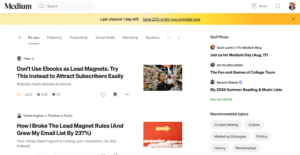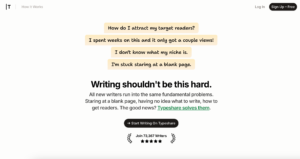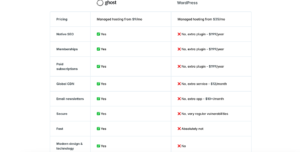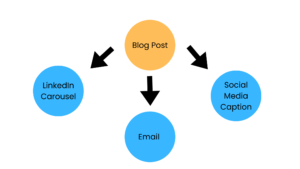I’m a huge advocate of having a blog, but you know what else is important?
People finding your content.
And the truth is, it’ll take time for people to find your blog content.
So how do you get your content in front of more people while your blog’s SEO does its thing?
Here’s where what I like to call alternative blogging platforms come in.
To get started building an online brand, you need to blog on platforms where there’s already an audience and drive traffic to your site.
That’s why today I’m sharing 5 alternative blogging platforms to get started building your online presence.
What Is An Alternative Blogging Platform?
For the purposes of this article, an alternative blogging platform is any alternatives to WordPress and Blogger.
Self hosted WordPress sites are the most common types of blogs and websites, but in order to drive traffic to them, you need a content distribution and SEO strategy.
The alternative blogging platforms in this article are sites where:
- There’s already an audience
- That you don’t have to build from scratch
- That don’t require a lot of tech knowledge to get started
In each section, you’ll find some basic information about each platform, pros and cons, and who I think the platform is best suited for.
Top 5 Alternative Blogging Platforms For Growing Your Online Brand
1. Medium
Medium is an amazing platform because it’s already full of writers who want to actually engage with you about your work.

For $5/month, you can get a Medium membership and read paywalled articles and join the Medium partnership program and make money from your writing.
I personally love Medium because it’s a great platform to actually have discussions about your industry and learn new things.
There are also over 63 million active users on Medium ready to discover you.
Here are some more thoughts on Medium:
Pros
- It’s super easy to register and start creating content
- Vibrant community with a ton of niches
- People actually want to engage in discussions
- The content is usually short and accessible
Cons
- You have to amass a big following & lots of views to make real money there
- It’s hard to find the most recent content vs trending content
Who Should Use Medium
Writers looking to build a following who want to have a big library of online content to showcase.
2. Substack
Substack is a newsletter-blogging platform focused on monetizing through paid newsletter subscriptions. You can charge monthly and annual fees to gate your best content.
I like this idea in theory because everyone deserves to have their work monetized, but starting out I wasn’t comfortable charging money when I didn’t even have any subscribers so I didn’t know what people wanted.
The platform really pushes monetization and tries to get you to add a payment method every time you log on so that got annoying for me.
However, I really loved the content on Substack. A lot of people in my industry are on it so the options of content to consume were endless.
People also really value intellectual discussions on Substack, and from what I saw it was mostly respectful.
Here are some other pros and cons of this platform:
Pros
- Easy to understand and setup monetization
- All the content I read was honestly good across the board
Cons
- May not make sense for someone growing an audience
- They really pressure you to monetize
- If you want to read other people’s content, you have to subscribe individually vs subscribing to the whole platform, which can make it expensive for users

Who Should Use Substack
Writers looking to monetize their content easily and write for an audience of engaged users.
3. Typeshare
Typeshare is a platform for atomic blogging created by writers Dickie Bush and Nicolas Cole of Ship30for30.
The platform is tied to their digital writing course and encourages users to create short “atomic essays” for 30 days to improve their storytelling and digital writing abilities.

You don’t have to be a member of Ship30for30 to join Typeshare, but you may get more out of it if you learn their online writing philosophy and go through the course. Ship30 is one of the few courses on online writing that I feel is actually valuable and current and is actually fairly evergreen in terms of what it teaches.
When you sign up for Typeshare premium, you can get access to a whole bunch of prompts and templates to make writing online easier.
These are proven templates that Dickie and Cole actually use in their content (you can easily find a ton of them if you scroll through their X accounts).
The templates are great for content across platforms, so you don’t only have to post to Typeshare; you can share the content on other platforms as well.
Here are some of my closing thoughts on Typeshare:
Pros
- Templates make it easier to get started writing online
- Easy to share to other platforms
- Built-in community who’s also interested in writing online
- New templates constantly added
- Great for getting started writing online
Cons
- Little engagement on the actual platform, as far as I can tell
- Limited formatting options when you share directly from Typeshare
Who Should Use Typeshare
Beginner writers looking to improve their writing quickly.
4. LinkedIn
Wait, wait; I know you’re already cringing, but hear me out.
LinkedIn gets a bad rap as a social media platform for being stuffy and bro-y, but it can also be super valuable if you want to get results from your content that improve your business or career.
What’s great about using LinkedIn as an alternative blogging platform is there are over 1 billion users worldwide but only 3 million post weekly.
That means there’s a huge gap that you could fill with your content and become one of the top posters really quickly.
With a ton of users but fewer people posting, the platform isn’t as saturated as other social media platforms, giving you a great opportunity to build your audience.
If you’re an agency or other business selling services to businesses, you absolutely need to be on LinkedIn.
B2B providers who aren’t already posting on LinkedIn are missing out on major opportunities to network with and attract future clients.
Still not convinced? Let’s look at these pros and cons for writing on LinkedIn:
Pros
- Ideal for B2B businesses
- Not overly saturated and hard to grow on
- You’ll be able to position yourself as a thought leader in your industry
- LinkedIn profiles are ranked well in search results, bringing more traffic to your posts
- Major lead generation opportunities through posting content
Cons
- You have to engage to achieve growth faster
- Content can get a little boring/templatized
- Big learning curve for figuring out what content works well
- Limited formatting options
Who Should Use LinkedIn
Writers, bloggers, and business owners who sell services to other businesses.
5. Ghost
Ghost is a fantastic platform for anyone who wants full control over their blog and a direct connection with their audience.
It’s a bit different from some of the other platforms we’ve talked about because it’s really geared toward serious writers and businesses who are ready to take their blogging to the next level.
One of the best things about Ghost is how fast it is.
This is super important for SEO because a fast-loading site increases positive user signals.
Ghost also gives you a ton of flexibility. It’s open-source, meaning you can customize just about anything—your site’s design, functionality, you name it.
Plus, if you’re tech-savvy, you can even host your blog on your own server. This makes Ghost a great choice if you want a unique site that really stands out.
Another cool feature is the built-in membership and subscription options.
If you’re thinking about monetizing your content, Ghost makes it super easy to set up paid newsletters, exclusive content, or even a full-blown membership site.
Here’s a quick rundown of what I love (and don’t love) about Ghost:
Pros
- It loads fast
- There are a ton of customization options
- You own your audience
- Easy to create memberships and offer paid content
- It’s open source so you have full control over the platform
Cons
- There’s a bit of a learning curve so you need to be tech savvy to use it
- It’s more similar to having your own website, so you have to drive traffic to it

Who Should Use Ghost
Tech-savvy writers who are further in their career and want more monetization options.
Ready To Start Blogging?
WordPress might be the most popular place to start a blog, but if you want to grow an audience more quickly, there are definitely some great alternative blogging platforms to use.
Platforms like Medium, Substack, Typeshare, LinkedIn, and Ghost offer unique opportunities to connect with your audience, grow your brand, and even monetize your content.
Each of these alternative platforms has its own strengths, so the best choice really depends on your specific goals and the type of content you want to create.
Start by exploring these platforms and see which one feels like the right fit for your brand and where you are in your writing journey.
Next, start posting. If you’re stuck on what to write about and how to grow, check out the other resources on this blog to get started.


